You’ll find these 2 medicinal herbs to forage in vacant lots, on the side of the road, in meadows and on pathways all over North America and Europe. Foraging medicinal herbs is easy and even children can be taught to identify and use these two medicinal herbs.
With just these two plants you have a first aid kit in your hands. These two plants can be found in most places in North America both in the city and in the countryside or even along the road. Even children can be taught how to identify them and use them. And they can make a huge difference when you are in a remote place and you bang your shin into the trailer hitch in the dark. Believe me!
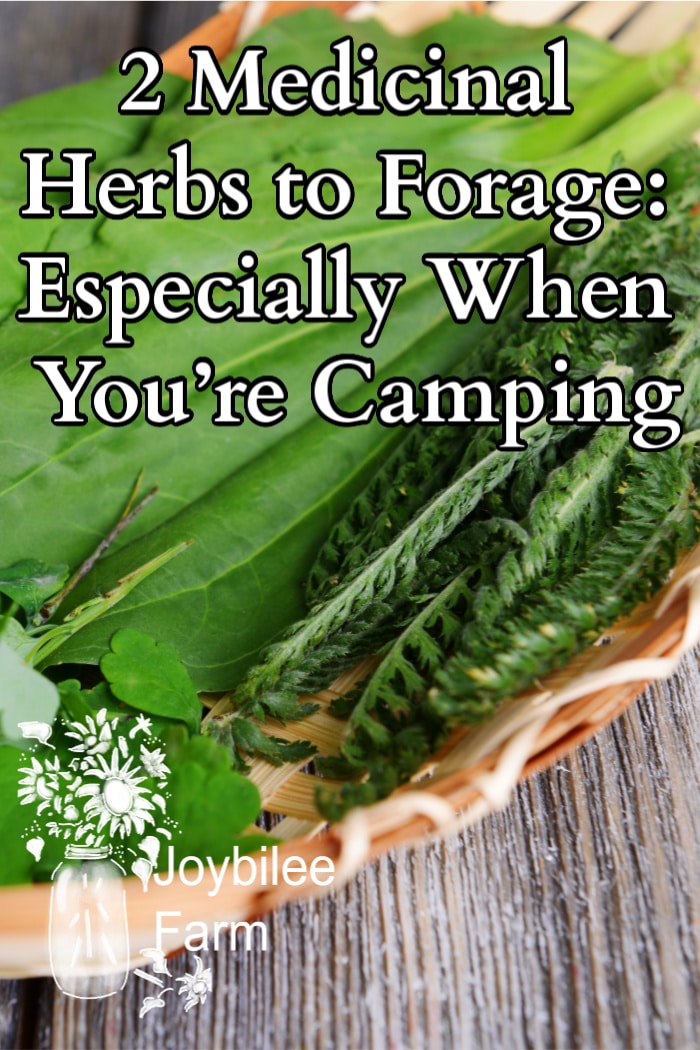
What do you do if you are on a road trip or a camping trip and you need a remedy but you don’t have it? It happens to all of us at one time or another. If you’ve been paying attention and getting to know your herbal allies you’ll know exactly which medicinal herbs to forage, because herbs have many uses — not just the one use that they are most known for.
I tell my students that you don’t need 100 different herbs in your herb stash to use herbal remedies effectively. You just need a few herbs that you know really, really well. Because herbs can be used for many different things. You can forage medicinal herbs in most places whether that’s on a camping trip in the forest, or a city street. There are medicinal herbs to forage all around you.
Medicinal Herbs to Forage in the City
Last summer I was in a coffee shop, in our little town, and a lady came in and asked the owners for ice. She sat down at the table next to me and gingerly rubbed her finger with an ice cube. She was riding her motor bike and a bee stung her finger.
I asked her if she would like something better than ice for her finger. She nodded. I went outside to the vacant lot next to the restaurant. It didn’t take me more than a few seconds to find a small plantain leaf. I took it into the washroom and washed the dust off it and gave it to the woman. I told her to mush it up in her fingers and put it on her sting. (She could have chewed it up to put it on the finger. But I didn’t want to gross her out.) She did it and in just a few minutes she had relief.
Her relief came so quickly that other people in the restaurant noticed and wanted to know what plant I gave her. It was a teaching moment.
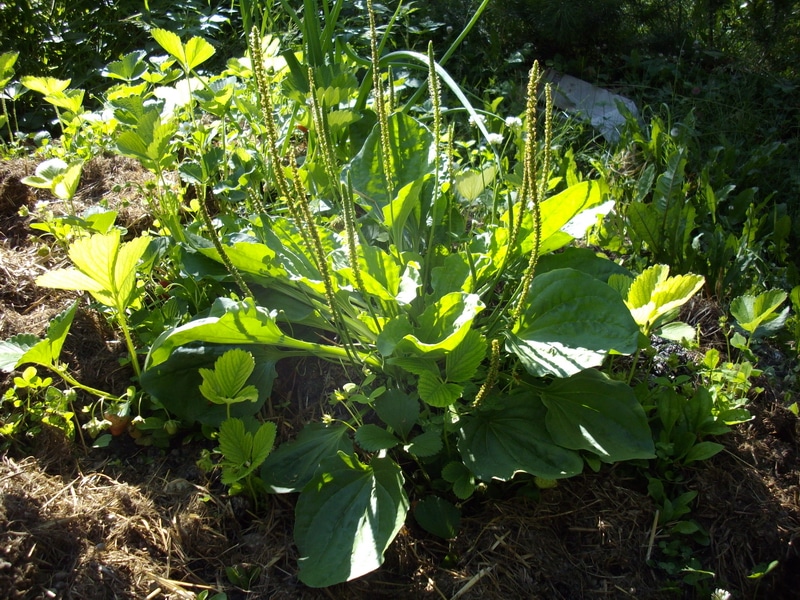
Plantain — Medicine Leaf
My granddaughters were visiting me on the weekend and my eldest granddaughter, Celia (she’s 9), told me that when she gets a bee sting she grabs a plantain leaf and puts it on the sting and the sting goes away. Bravo! It’s so important to teach this plant wisdom to your children and your grandchildren. Children as young as 3 can learn this wisdom, just like they can learn not to put things in their mouths.
Plantain is soothing; it’s used to draw poison out of a wound. It can be used as a poultice for stings, scrapes, scratches, bites, rashes, and deep wounds. But it can also be used to soothe a stomach ache, and reduce swelling in a sore joint.
Plantain was once called “Medicine Leaf”. It can be used to stop bleeding, and to promote the healing of wounds and injuries. It can also relieve pain and inflammation internally, healing from the inside out.
A tea made with plantain can soothe a sore throat, act as an expectorant for tight, congested chests, and ease diarrhea or hemorrhoids. And ironically the seeds of plantain can be used as a laxative. It’s good for many digestive issues.
You can find plantain anywhere that the ground has been disturbed: Foot paths, garden beds, road sides, pastures, grassy fields, or vacant lots. The better the soil, the more luxuriously the leaves will grow. But tiny plantain growing in poor soil is just as effective as lush plantain growing beside a garden bed. Both the leaves and the seeds are used in herbal medicine. The seeds are laxative and add fiber to the diet. The leaves have the drawing, soothing actions. Young plantain leaves can even be used as a pot herb or salad green. The older leaves get quite stringy, so if you want to eat them choose the young spring leaves, and of course, make a positive identification before you cook them.
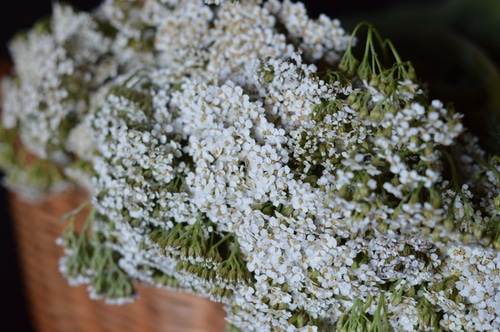
Yarrow — Wound Wort
Another useful herb to know is yarrow. You’ll see it growing on the roadside in many places and in areas where the soil is poor. It’s an opportunistic plant. Yarrow flowers and leaves are used to stop bleeding, use it for nose bleeds, cuts, scrapes, and deep bruises. The kind you get on your shin when you meet the trailer hitch in the dark.
Yarrow eases pain, reduces inflammation, and it will move the fluid in the tissues to heal old bruises. My daughter recently got a concussion at work, and she drank some yarrow tea, made from weeds she found in her backyard, and the next morning when she woke up, not only was her head less painful, but some old bruises she’d had for weeks were gone.
A tea made with yarrow flowers can make you sweat, opening capillaries and speeding up healing from viruses and fevers. It aids digestion and supports circulation and normalizes blood pressure. It is antimicrobial and helps in persistent bladder infections. Yarrow is also antiviral and eases menstrual discomfort. If there is stagnation or congestion somewhere in the body, yarrow helps to move it along.

Yarrow has fine, lacy leaves and many flowers on one flower head. It smells pungent and medicinal. When you are picking it, your fingers can go numb because of the active analgesic in the plant. It relieves pain quickly. You can use the flowers, the leaves or both when using it for herbal remedies.
(Note: if you are allergic to yarrow or plantain, these may not be your herbs. If you are pregnant, yarrow may be too strong an herb for you to use internally. You can still use yarrow in a salve though. Speak to your midwife for specific recommendations)
Two herbs make a medicine chest
That’s two easy to find herbs that grow in most places in North America and Europe. If you’ve never met yarrow or plantain in the wild, get a field guide from the library to help you identify them or ask a friend who hikes to point them out to you. (Never be presumptuous when harvesting herbs in the wild. Always confirm their identity using three independent sources before you harvest a new-to-you plant for food or medicine. Only YOU can keep YOU safe. )
That kind of knowledge — that hands on, get your hands dirty, DIY knowledge of herbs is what makes you strong. And you can’t get it from sitting behind a screen. You need to get out of the house to see and smell the plants. Touch them. Get to know them as your herbal allies.
Where to forage medicinal herbs
One more thing, when you are on a road trip, and you need a plantain leaf or a couple of yarrow flowers, don’t harvest from the side of the highway. Those herbs will be contaminated with road dust and chemicals. But use the herbs on the side of the road to guide you to where you can find them — on a turn off down a country road. Because where you see an herb growing tells you where it’s mates can be found. (Always make sure you have permission to harvest herbs where you find them).
Honestly, I’ve just scratched the surface here on what you can use from the wild, if you are on a road trip or a camping trip and you need an herbal remedy.
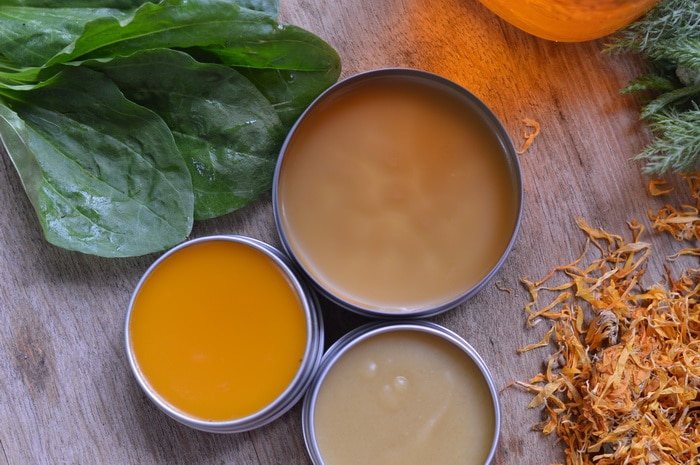
25 Ways to Use these 2 Medicinal Herbs
Here are some of the problems that these two foraged herbs can help the body resolve.
- Bee Stings
- Bladder Infection
- Bruises
- Bumps on the Head
- Colds and Flu
- Constipation
- Coughs
- Cuts
- Diarrhea
- Fevers
- Flatulence
- Hemorrhoids
- Heartburn
- Itchy rashes
- High Blood Pressure
- Minor Burns
- Mosquito Bites
- Nose Bleeds
- Period Cramps
- Slivers
- Sore Joints
- Sore Throat
- Stomach Ache
- Sunburn
- Walking into the Trailer Hitch in the Dark
Healing salve to make with foraged herbs
Plantain and yarrow are two of the herbs in this easy to make healing salve. Grab the recipe while you are here.
Learn to know your herbal allies so that you know which herbs to forage when you are on a camping trip or a road trip and need a remedy you didn’t bring with you. As you set up camp, just take a walk around the site and note where you can find these two powerful herbal allies, so that if you need them you know where to look. And once you know how to use these two powerful medicinal herbs to forage, please tell your children and your grand children. We need to pass this on to the next generation.
The DIY Herbal First Aid Travel Kit Course
My class The DIY Herbal First Aid Travel Kit, goes into more detail on the herbal remedies you can make for your next road trip and how you can get to know a few of your herbal allies better.
In the class you’ll learn to identify some wild medicinal herbs to forage, you’ll also learn how to use some of your kitchen spices for herbal remedies. If you are new to herbs, this short class will help you gain confidence quickly.
Click on the button below to learn more about this class.


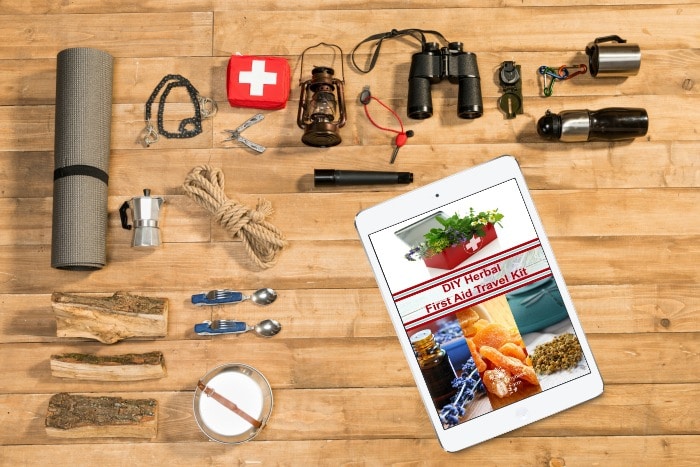


Love your website! Thank you! For the The DIY Herbal First Aid Travel Kit, which plants will be covered in the course?
I work with Preschoolers and often they get booboo’s on the playground. I will search around for a plantain, and wrap a “Mother Nature’s Bandaid” around the wound (usually a finger). They gleefully trot away to play while holding the leaf in place with other fingers of the same hand. One day as we were on a walk, one of the boys said, “Hey look, some ‘mother nature bandaid’! I beamed with pride and in my heart I know I am making a difference!
I love all your helpful info and I learn something new all the time! One of your most used in my household is the Bidens Tincture. It is a big time ‘go to’ in my family and spreading among my friends as well. Thanks for sharing your wisdom!
You can dig up plants anytime, but if it’s hot where you live, it’s better to transplant in spring or fall when there is ample rain and the weather is cooler.
I have scoured my yard and find no plantain BUT while visiting my brother last week I noted that his yard is just full of it! How can I transplant some to my yard and when is the best time to do this?
I found a nest of ground bees in my front yard yesterday and while dousing them with vinegar late last evening I discovered they had left a nightwatchman to wait for me. The sting was very painful and swelled quickly. There are many plantain plants right by my back door and I grabbed a leaf, chewed it, and applied it to the sting. It helped some but I decided I needed more. While I kept the first poultice in place with a piece of tape I gathered some more leaves, shredded them with a knife, and then the handheld blender. I applied them and taped them in place overnight. Could hardly tell I had a sting this morning. Just a slight ache. Thanks for your teachings.